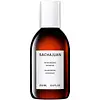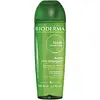What's inside
What's inside
 Key Ingredients
Key Ingredients

 Benefits
Benefits

 Concerns
Concerns

 Ingredients Side-by-side
Ingredients Side-by-side

Water
Skin ConditioningSodium Laureth Sulfate
CleansingCocamidopropyl Betaine
CleansingGlycerin
HumectantPEG-7 Glyceryl Cocoate
EmulsifyingPEG-4 Rapeseedamide
Parfum
MaskingSodium Benzoate
MaskingHydroxypropyl Guar Hydroxypropyltrimonium Chloride
Coco-Glucoside
CleansingGlyceryl Oleate
EmollientCitric Acid
BufferingSodium Chloride
MaskingPEG-150 Pentaerythrityl Tetrastearate
EmulsifyingLinalool
PerfumingPEG-6 Caprylic/Capric Glycerides
EmulsifyingArgania Spinosa Kernel Oil
EmollientLimonene
PerfumingBenzyl Salicylate
PerfumingHexyl Cinnamal
PerfumingAlpha-Isomethyl Ionone
PerfumingChondrus Crispus Extract
Skin ConditioningCitronellol
PerfumingWater, Sodium Laureth Sulfate, Cocamidopropyl Betaine, Glycerin, PEG-7 Glyceryl Cocoate, PEG-4 Rapeseedamide, Parfum, Sodium Benzoate, Hydroxypropyl Guar Hydroxypropyltrimonium Chloride, Coco-Glucoside, Glyceryl Oleate, Citric Acid, Sodium Chloride, PEG-150 Pentaerythrityl Tetrastearate, Linalool, PEG-6 Caprylic/Capric Glycerides, Argania Spinosa Kernel Oil, Limonene, Benzyl Salicylate, Hexyl Cinnamal, Alpha-Isomethyl Ionone, Chondrus Crispus Extract, Citronellol
Water
Skin ConditioningCaprylyl/Capryl Glucoside
CleansingPEG-150 Distearate
EmulsifyingPEG-6 Caprylic/Capric Glycerides
EmulsifyingPEG-15 Cocopolyamine
EmulsifyingSodium Lauroyl Oat Amino Acids
CleansingLactic Acid
BufferingSodium Citrate
BufferingCaprylyl Glycol
EmollientQuaternium-80
Propylene Glycol
HumectantMannitol
HumectantXylitol
HumectantRhamnose
HumectantPhenoxyethanol
PreservativeTetrasodium EDTA
Ethylhexylglycerin
Skin ConditioningFructooligosaccharides
HumectantSodium Hydroxide
BufferingParfum
MaskingWater, Caprylyl/Capryl Glucoside, PEG-150 Distearate, PEG-6 Caprylic/Capric Glycerides, PEG-15 Cocopolyamine, Sodium Lauroyl Oat Amino Acids, Lactic Acid, Sodium Citrate, Caprylyl Glycol, Quaternium-80, Propylene Glycol, Mannitol, Xylitol, Rhamnose, Phenoxyethanol, Tetrasodium EDTA, Ethylhexylglycerin, Fructooligosaccharides, Sodium Hydroxide, Parfum
Alternatives
Ingredients Explained
These ingredients are found in both products.
Ingredients higher up in an ingredient list are typically present in a larger amount.
Parfum is a catch-all term for an ingredient or more that is used to give a scent to products.
Also called "fragrance", this ingredient can be a blend of hundreds of chemicals or plant oils. This means every product with "fragrance" or "parfum" in the ingredients list is a different mixture.
For instance, Habanolide is a proprietary trade name for a specific aroma chemical. When used as a fragrance ingredient in cosmetics, most aroma chemicals fall under the broad labeling category of “FRAGRANCE” or “PARFUM” according to EU and US regulations.
The term 'parfum' or 'fragrance' is not regulated in many countries. In many cases, it is up to the brand to define this term.
For instance, many brands choose to label themselves as "fragrance-free" because they are not using synthetic fragrances. However, their products may still contain ingredients such as essential oils that are considered a fragrance by INCI standards.
One example is Calendula flower extract. Calendula is an essential oil that still imparts a scent or 'fragrance'.
Depending on the blend, the ingredients in the mixture can cause allergies and sensitivities on the skin. Some ingredients that are known EU allergens include linalool and citronellol.
Parfum can also be used to mask or cover an unpleasant scent.
The bottom line is: not all fragrances/parfum/ingredients are created equally. If you are worried about fragrances, we recommend taking a closer look at an ingredient. And of course, we always recommend speaking with a professional.
Learn more about ParfumThis ingredient is derived from caprylic and capric acids. It is an emulsifier with emollient properties.
According to the manufacturer, it is hydrophilic and soluble in aqueous solutions (water). They also state this ingredient is stable in a medium pH range (~5 - 8).
As an emulsifier, it helps make oils and oil-soluble ingredients more soluble in water.
Learn more about PEG-6 Caprylic/Capric GlyceridesWater. It's the most common cosmetic ingredient of all. You'll usually see it at the top of ingredient lists, meaning that it makes up the largest part of the product.
So why is it so popular? Water most often acts as a solvent - this means that it helps dissolve other ingredients into the formulation.
You'll also recognize water as that liquid we all need to stay alive. If you see this, drink a glass of water. Stay hydrated!
Learn more about Water